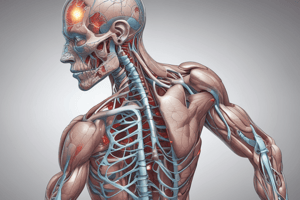Podcast
Questions and Answers
Which type of diagnosis guides us in getting a more thorough history and physical examination?
Which type of diagnosis guides us in getting a more thorough history and physical examination?
- Syndromic Diagnosis (correct)
- Pathologic/Etiologic Diagnosis
- Topographic/Anatomic Diagnosis
- Functional Diagnosis
What is an example of a syndrome that can be identified through syndromic diagnosis?
What is an example of a syndrome that can be identified through syndromic diagnosis?
- Sudden right-sided weakness and inability to speak (correct)
- Fever, headache, seizures
- Progressive worsening of headache
- All of the above
Which step in the diagnosis of neurologic diseases involves recognizing a characteristic clustering of symptoms and signs?
Which step in the diagnosis of neurologic diseases involves recognizing a characteristic clustering of symptoms and signs?
- Functional Diagnosis
- Pathologic/Etiologic Diagnosis
- Syndromic Diagnosis (correct)
- Topographic/Anatomic Diagnosis
What does syndromic diagnosis allow us to develop?
What does syndromic diagnosis allow us to develop?
What type of diagnosis is conducted in parallel with syndromic diagnosis?
What type of diagnosis is conducted in parallel with syndromic diagnosis?
Which of the following is NOT a type of diagnosis in the diagnosis of neurologic diseases?
Which of the following is NOT a type of diagnosis in the diagnosis of neurologic diseases?
Which of the following is an example of syndromic diagnosis?
Which of the following is an example of syndromic diagnosis?
What does syndromic diagnosis allow us to develop?
What does syndromic diagnosis allow us to develop?
Which step in the diagnosis of neurologic diseases involves recognizing a characteristic clustering of symptoms and signs?
Which step in the diagnosis of neurologic diseases involves recognizing a characteristic clustering of symptoms and signs?
Which type of diagnosis guides us in getting a more thorough history and physical examination?
Which type of diagnosis guides us in getting a more thorough history and physical examination?
Flashcards are hidden until you start studying
Study Notes
Diagnostic Approaches in Neurologic Diseases
- Syndromic diagnosis guides us in getting a more thorough history and physical examination.
- An example of a syndrome that can be identified through syndromic diagnosis is Todd's paralysis.
- Pattern recognition is the step in the diagnosis of neurologic diseases that involves recognizing a characteristic clustering of symptoms and signs.
- Syndromic diagnosis allows us to develop a differential diagnosis.
- Etiologic diagnosis is conducted in parallel with syndromic diagnosis.
- Anatomical diagnosis is NOT a type of diagnosis in the diagnosis of neurologic diseases.
- Multiple sclerosis is an example of syndromic diagnosis.
- Syndromic diagnosis allows us to develop a list of possible causes of a patient's symptoms.
- Pattern recognition is the step in the diagnosis of neurologic diseases that involves recognizing a characteristic clustering of symptoms and signs.
- Syndromic diagnosis guides us in getting a more thorough history and physical examination.
Studying That Suits You
Use AI to generate personalized quizzes and flashcards to suit your learning preferences.




